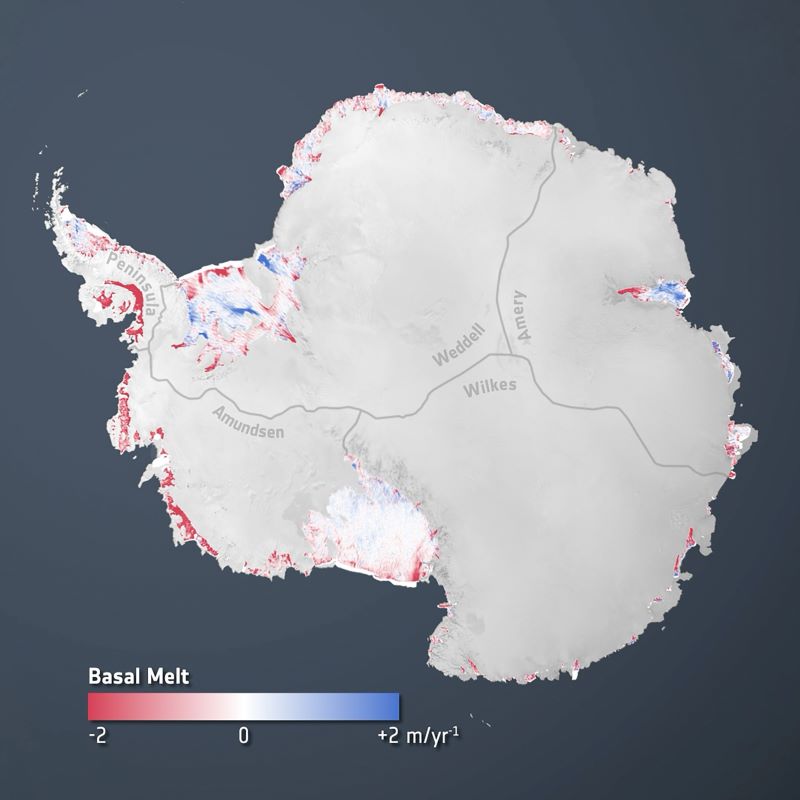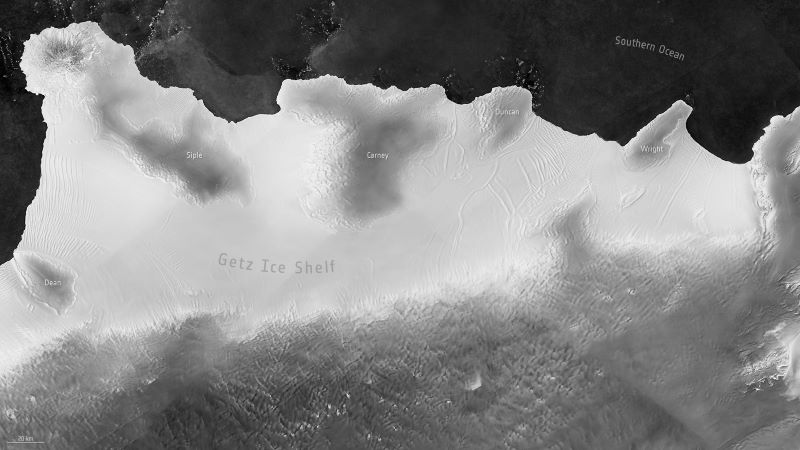The Arctic is an ocean, surrounded by continents. But Antarctica is a continent, surrounded by ocean. As snow falls on Antarctica each winter, the ice on Earth’s southernmost continent builds. It then slides, under its own weight, toward the surrounding ocean, to create Antarctica’s great ice shelves, extending from the continent and floating atop sea water. Antarctica’s ice shelves buttress the continent’s glaciers. They stabilize the glaciers and slow glacial flow into the ocean. But new research – using satellite data – shows that 40% of Antarctica’s floating ice shelves have lost significant volume over the past 25 years. An October 13, 2023, statement from the European Space Agency (ESA) on this subject called the finding alarming and a double whammy.
The double aspect is due to the loss not only from the floating ice shelves, but also from the continental itself via the increasing flow from Antarctica’s glaciers to the sea. Of course, the loss isn’t uniform across the continent. Is anything in nature precisely uniform?
The researchers published their study in the peer-reviewed journal Science Advances on October 12, 2023.
The 2024 lunar calendars are here! Best Christmas gifts in the universe! Check ’em out here.
Antarctic ice shelves emptying into the ocean
The researchers used 100,000 satellite radar images, largely from Copernicus’ Sentinel-1 and ESA’s CryoSat satellite missions, to study Antarctic ice shelves from 1997 to 2021. What they found was that 71 of the 162 ice shelves around Antarctica have shrunk in volume.
The researchers expected the ice in Antarctica to follow a pattern of shrinking and regrowth. But that’s not what they saw. Benjamin Davison of the University of Leeds said:
We expected most ice shelves to go through cycles of rapid, but short-lived shrinking, then to regrow slowly. Instead, we see that almost half of them are shrinking with no sign of recovery.
These shrinking ice sheets have released nearly 67 trillion metric tons of melted water into the ocean. This melted water is freshwater, not salty, and its entry into the ocean could affect circulation patterns. According to Ocean-Climate.org:
This input of freshwater, by decreasing surface water density near the poles, could limit downwelling, prevent deep waters formation, slowing down global circulation.

Melting in Antarctica is not uniform
The satellite data showed that the loss of ice in Antarctica is not uniform. On the western side of the continent, nearly all the ice shelves had some ice loss. But on the eastern side, most ice shelves are protected by a band of cold water at the coast. They are relatively stable, for now. Davison said:
There is a mixed picture of ice-shelf deterioration, and this is to do with the ocean temperature and ocean currents around Antarctica.
The western half is exposed to warm water, which can rapidly erode the ice shelves from below, whereas much of East Antarctica is currently protected by a band of cold water at the coast.
And as we learned last month, Antarctica had wild weather in 2022, with unprecedented snowfall on the eastern side, offsetting ice loss and protecting against sea level rise. But, at the same time, it was the second-warmest year on record in Antarctica, and:
More than 100 daily low sea-ice extent and sea-ice area records were set in 2022, including two new all-time annual record lows in net sea-ice extent and area in February.
Antarctic ice shelves on the western side
Antarctica is roughly the size of the United States and Mexico combined, or twice the size of Australia. On Antarctica’s west side, warmer seawater dives under the ice shelves, melting them from below. Therefore, the Getz Ice Shelf, in the southwest corner of the continent, experienced some of the largest losses. The Getz Ice Shelf lost 1.9 trillion metric tons of ice during the 25-year period. Calving – where chunks of ice fall into the ocean – accounted for 5% of the loss. The rest was due to melting.
The Pine Island Ice Shelf on the west side is also melting fast. It lost 1.3 trillion metric tons of ice during the period of study. About 1/3 of this was due to calving, and the rest was from melting on the underside of the ice shelf. (The Pine Island Ice Shelf or glacier is a neighbor to the famous Thwaites “Doomsday” Glacier.)
And on the other side of the continent, the Amery Ice Shelf in its frigid waters has gained 1.2 trillion metric tons of ice.

A warming climate
Anna Hogg from the University of Leeds summed up the situation:
The study has generated important findings. We tend to think of ice shelves as going through cyclical advances and retreats. Instead, we are seeing a steady attrition [reduction/ decrease] owing to melting and calving.
Many of the ice shelves have deteriorated a lot: 48 lost more than 30% of their initial mass over just 25 years. This is further evidence that Antarctica is changing because the climate is warming.
Bottom line: A new study reported that Antarctic ice shelves are losing volume, with the west side of the continent seeing the greatest losses.
Source: Annual mass budget of Antarctic ice shelves from 1997 to 2021











